#Celtic Christianity
Text
People with cures in Ireland are people with a special ability to heal a certain aspect of sickness through a procedure of incantation, apparatus and faith. This a practice which is still going on to this day.
Recently, Cecily Gilligan wrote a book called Cures of Ireland: A treasure trove of irish remedies
Which really is the ultimate book on Cures, she has being doing research since at least the 80s on this topic. Would highly recommend.

#irish paganism#resources#celtic paganism#gaelic paganism#magic#folklore#celtic Christianity#ireland#my grandad was one of the people documented in the book so i was v excited#mine
120 notes
·
View notes
Text


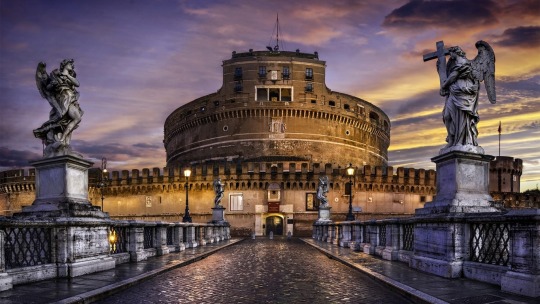


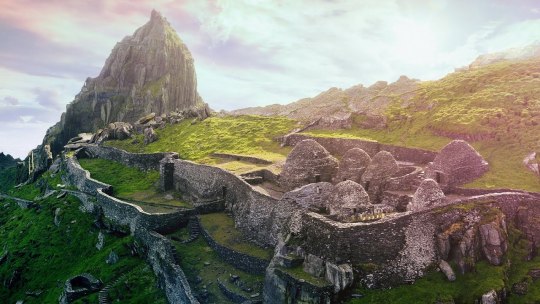


Shrines to St. Michael.
"Mountains figure prominently at the mighty ganglia of the story of Christianity... As Jesus prays atop the holy mountain, the other world intersects with ours as the divine comes down to the human, as the eternal touches the temporal and mortal. And that other world is the ultimate reality, not this one. No wonder that St Michael, ‘Quis ut Deus,’ has his shrines on lofty peaks; no wonder the Celts worshipped on hills and mountains...
The spirit of the Archangel Michael permeates discussion of the world of the Celts—shrines such as Skellig Michael on precipitous mountain-tops in the cold and wet Celtic desert; early connections with the ancient Eastern world; guardianship of Tuscany, Provence, Normandy, and Cornwall; safe-keeping of wanderers and hermits; motifs of spear, sword, and stone; waging of the war in Heaven and the downfall of Lucifer; the communion of the Grail."
St. Michael: Early Anglo-Saxon Tradition, Raymond JS Grant
(1) Mont St. Michel, Normandy, France; (2) St. Michael’s Mount, Cornwall, England; (3) Castel Sant’Angelo, Rome, Italy; (4) Saint-Michel d’Aiguilhe, Le Puy-en-Velay, France; (5) Abbey of San Galgano, Siena; (6) Skellig Michael, County Kerry, Ireland; (7) Sacra di San Michele, Mount Pirchiriano, Turin, Italy; (8) St. Michael’s Tower, Glastonbury Tor, England
#st michael#saint michael the archangel#mont saint michel#st michael's mount#castel sant'angelo#saint-michel d'aiguilhe#skellig michael#glastonbury#glastonbury tor#celtic christianity#celtic#celts
53 notes
·
View notes
Text

(Vulgate Cycle - Mort Artu)

(Post-Vulgate Cycle - Mort Artu)
SIGH
On one hand, I don't like the idea that Guinevere can't handle Monastic/Ascetic Life.
On the other Hand, I'm really resentful with Modern Arthuriana that have Guinevere be convent-raised/educated.
#a rock and a hard place#monasticism#clerical necromancy#medieval education#queen guinevere#lancelot grail#vulgate cycle#post vulgate#mort artu#arthuriana#arthurian legend#arthurian mythology#arthurian legends#the mists of avalon#celtic christianity
6 notes
·
View notes
Text
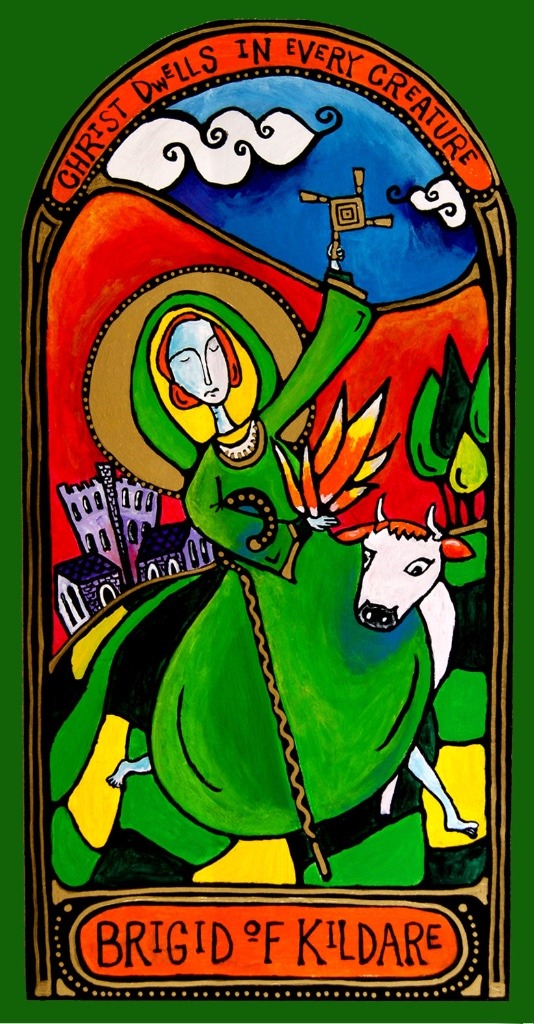
Dancing monk icon by Marcy Hall Art
* * * *
Blessings on this eve of the Feast of St. Brigid!
I feel especially blessed to have had the joy of joining with a group of dancing monks online last Monday to celebrate Brigid's call to us as midwife, muse, and transforming fire.
February 1st-2nd marks a confluence of several feasts and occasions including: the Celtic feast of Imbolc, St. Brigid’s Day, Candlemas, Feast of the Presentation, and Groundhog Day in the northern hemisphere! (Imbolc is August 1st in the southern hemisphere).
Imbolc is a Celtic feast that is a cross-quarter day, meaning it is the midway point between the winter solstice and spring equinox. The sun marks the four Quarter Days of the year (the Solstices and Equinoxes) and the midpoints are the cross-quarter days. In some cultures, like Ireland, February 2nd is the official beginning of spring.
As the days slowly lengthen in the northern hemisphere and the sun makes her way higher in the sky, the ground beneath our feet begins to thaw. The earth softens and the seeds deep below stir in the darkness. The word “imbolc” means “in the belly.” The earth’s belly is beginning to awaken, new life is stirring, seeds are sprouting forth.
In many places the ground is still frozen or covered with snow, but the call now is tend to those very first signs of movement beneath the fertile ground. What happens when you listen ever so closely in the stillness? What do you hear beginning to emerge?
St. Brigid is said to bring the first sign of life after the long dark nights of winter. She breathes into the landscape so that it begins to awaken. Snowdrops, the first flowers of spring are one of her symbols.
On the eve of January 31st it is traditional to leave a piece of cloth or ribbon outside the house. It was believed that St Brigid’s spirit traveled across the land and left her curative powers in the brat Bride (Brigid’s Mantle or cloth). It was then used throughout the year as a healing from sickness and protection from harm.
Often in Ireland, I have heard Brigid described as a bridge between the pre-Christian and Christian traditions, between the other world and this one. She bridges the natural and human world. Brigid sees the face of Christ in all persons and creatures, and overcomes the division between rich and poor. Our practice of inner hospitality as monks in the world is essentially about healing all of places we feel fragmented, scattered, and shamed. One of her symbols is her cloak which becomes a symbol of unity. All can dwell under her mantle.
[Thanks to Christine Valters Paintner and to the dancing monks]
#Saint Brigid#Ireland#the Dancing Monks#Christine Valters Paintner#celtic christianity#imbolc#in the belly#seasons#winter#feast days
8 notes
·
View notes
Text
Dairthech, Clonmacnoise, Co.Offaly

In Gaelic Ireland, between the 5th and 9th centuries AD, a dairthech (literally "oak-house") was a type of oratory or church built of oak-wood. This is a reconstruction of a dairthech, a typical small oak church, such as the ones that may have stood at Clonmacnoise prior to their reconstruction in stone.
22 notes
·
View notes
Text
17th March
St Patrick’s Day/St Withburga’s Day/Passion Sunday

Source: RWS website
Today is St Patrick’s Day. A Scottish myth claims that Patrick was born near Glasgow, and that he was so holy, the Devil sent witches and demons to kill him. Patrick fled to Ireland and the infuriated forces of darkness lobbed a mighty rock after him which missed and became the hill on which Dumbarton Castle now stands. The Welsh say Patrick was born in Dyfed, while the English claim he was born in in Battersea in London. In actual fact it appears Patricius was a Romano-Briton, probably born in 389 near Norton in Northamptonshire. His Irish connection comes by virtue of the fact Irish pirates, a common problem for Roman Britain in the fourth century, raided deep into the province and kidnapped the 16-year old Patricius and sold him as a slave in Ireland where he became known as Padraig, or Patrick. Freed in adulthood, Patrick set up base in Armagh and set about converting the Irish to Christianity. His efforts met with extraordinary success and Patrick ended up not only founding Celtic Christianity, but was also canonised after his death and became the deserved patron saint of Ireland.
Various stories are told of Patrick, including how he rid Ireland of snakes by gathering them all up in a box and casting it into the Irish Sea. The frenetic attempts of the serpents to escape their prison is apparently what explains the Sea’s choppy nature. He is also supposed to have used the native three-leaved shamrock as a device to explain the tricky concept of the Holy Trinity to his pagan audience. Two shrines to Patrick exist, one containing his bell, the other one of his teeth and both are in the National Museum in Dublin.
Today is also St Withburga’s Day. A seventh century Abbess, Withburga was rumoured to have cured a draught in East Dereham Norfolk, by conjuring up two deer to provide an endless supply of milk to her starving nuns. She also appears as a dead ghost: her corpse can be seen being carried in an open coffin by her grieving devotees along the banks of the Little Ouse, near Ely, Cambridgeshire.
In 2024, today is also Passion Sunday, also known as Carling Sunday. In the north east of England carlings, or grey peas, are sold this week in pubs and supermarkets. Although local tradition says this practice commemorates a shipwreck in which a cargo of carlings were washed up on the beach, it is more likely explained by a pagan tradition of eating beans to remember the dead, Christianised on this day to commemorate the upcoming Passion of Christ.
#st patricks day#st Patrick#conversion of the Irish#celtic christianity#st withburga#passion Sunday#Dumbarton castle#norton#ireland#shamrock#carling sunday#passion of Christ#patricius
1 note
·
View note
Text
Today, the Church remembers St. David of Wales.
Ora pro nobis.
Saint David (Welsh: Dewi Sant, c. AD 500 – c. 589) was a Welsh bishop of Mynyw (now St Davids) during the 6th century AD. He is the patron saint of Wales. David was a native of Wales, and a relatively large amount of information is known about his life. However, his birth date is uncertain: suggestions range from 462 to 512. He is traditionally believed to be the son of Saint Non and the grandson of Ceredig ap Cunedda, king of Ceredigion. The Welsh annals placed his death AD 569 years after the birth of Christ, but Phillimore's dating revised this to AD 601.
Many of the traditional tales about David are found in the Buchedd Dewi ("Life of David"), a hagiography written by Rhygyfarch in the late 11th century AD. Rhygyfarch claimed it was based on documents found in the cathedral archives. Modern historians are sceptical of some of its claims: one of Rhygyfarch's aims was to establish some independence for the Welsh church, which had refused the Roman rite until the 8th c. AD and now sought a metropolitan status equal to that of Canterbury. (This may apply to the supposed pilgrimage to Jerusalem where he is said to have been anointed as an archbishop by the patriarch).
The tradition that he was born at Henfynyw (Vetus-Menevia) in Ceredigion is not improbable. He became renowned as a teacher and preacher, founding monastic settlements and churches in Wales, Dumnonia, and Brittany. St David's Cathedral stands on the site of the monastery he founded in the Glyn Rhosyn valley of Pembrokeshire. Around AD 550, he attended the Synod of Brefi, where his eloquence in opposing Pelagianism caused his fellow monks to elect him primate of the region. As such he presided over the synod of Caerleon (the "Synod of Victory") around 569 AD.
His best-known miracle is said to have taken place when he was preaching in the middle of a large crowd at the Synod of Brefi: the village of Llanddewi Brefi stands on the spot where the ground on which he stood is reputed to have risen up to form a small hill. A white dove, which became his emblem, was seen settling on his shoulder. David is said to have denounced Pelagianism during this incident and he was declared archbishop by popular acclaim according to Rhygyfarch, bringing about the retirement of Dubricius. St David's metropolitan status as an archbishopric was later supported by Bernard, Bishop of St David's, Geoffrey of Monmouth and Gerald of Wales.
The Monastic Rule of David prescribed that monks had to pull the plough themselves without draught animals, must drink only water and eat only bread with salt and herbs, and spend the evenings in prayer, reading and writing. No personal possessions were allowed: even to say "my book" was considered an offence. He lived a simple life and practised asceticism, teaching his followers to refrain from eating meat and drinking beer.
Rhigyfarch counted Glastonbury Abbey among the churches David founded. Around forty years later William of Malmesbury, believing the Abbey older, said that David visited Glastonbury only to rededicate the Abbey and to donate a travelling altar including a great sapphire. He had a vision of Jesus who said that "the church had been dedicated long ago by Himself in honour of His Mother, and it was not seemly that it should be re-dedicated by human hands". So David instead commissioned an extension to be built to the abbey, east of the Old Church. (The dimensions of this extension given by William were verified archaeologically in 1921). One manuscript indicates that a sapphire altar was among the items Henry VIII of England confiscated from the abbey during the Dissolution of the Monasteries a thousand years later.
Though the exact date of his death is not certain, tradition holds that it was on 1 March, which is the date now marked as Saint David's Day. The two most common years given for his death are 601 and 589 AD. The monastery is said to have been "filled with angels as Christ received his soul." His last words to his followers were in a sermon on the previous Sunday. The Welsh Life of St David gives these as, "Arglwydi, vrodyr, a chwioryd, Bydwch lawen a chedwch ych ffyd a'ch cret, a gwnewch y petheu bychein a glywyssawch ac a welsawch gennyf i. A mynheu a gerdaf y fford yd aeth an tadeu idi", which translates as, "Lords, brothers and sisters, Be joyful, and keep your faith and your creed, and do the little things that you have seen me do and heard about. And as for me, I will walk the path that our fathers have trod before us." "Do ye the little things in life" ("Gwnewch y pethau bychain mewn bywyd") is today a very well known phrase in Welsh. The same passage states that he died on a Tuesday, from which attempts have been made to calculate the year of his death.
David was buried at St David's Cathedral at St. Davids, Pembrokeshire, where his shrine was a popular place of pilgrimage throughout the Middle Ages. During the 10th and 11th centuries AD the Cathedral was regularly raided by Vikings, who removed the shrine from the church and stripped off the precious metal adornments. In AD 1275 a new shrine was constructed, the ruined base of which remains to this day, which was originally surmounted by an ornamental wooden canopy with murals of David, Patrick and Denis. The relics of David and Justinian of Ramsey Island were kept in a portable casket on the stone base of the shrine. It was at this shrine that Edward I came to pray in AD 1284. During the reformation Bishop Barlow (AD 1536–48), a staunch Protestant, sacrilegiously stripped the shrine of its jewels and confiscated the relics of David and Justinian.
Almighty God, you called your servant David to be a faithful and wise steward of your mysteries for the people of Wales: Mercifully grant that, following his purity of life and zeal for the Gospel of Christ, we may with him receive our heavenly reward; through Jesus Christ our Lord, who lives and reigns with you and the Holy Spirit, one God, forever and ever.
Amen.

#father troy beecham#christianity#jesus#saints#god#salvation#peace#faith#early church#monasticism#Celtic Christianity
7 notes
·
View notes
Quote
Wherever I roam
Make me a blessing.
That people may see
I am a blessing,
For you are with me.
The Open Gate: Celtic Prayers for Growing Spiritually by David Adam
20 notes
·
View notes
Text
“All Are Welcome” based on Hosea 11:1-4 and Matthew 28:16-20

Sometimes I get distracted. Not just the normal distracted of turning to my phone when it buzzes or letting the internet take me down rabbit holes (although those happen too.) Sometimes I get so distracted talking about what kind of Christian I am NOT that I forget to talk about what kind of Christian I am.
In fact, that's so true that I'm squirmy already, as the word Christian is overly affiliated in my head with things I struggle with. One of you once said that “Jesus follower” worked better for you than Christian for just that reason. And I love that. But also, “Christian” means “little Christ” and I do think the whole point is to continue the work of Christ in the world and it is probably worth the discomfort involved in claiming it anyway.
A friend and colleague, the Rev. Andrew Nelson, recently dropped a book off for me. Which is a great way to share love, particularly when this was a book I'd been looking for and not finding for years! I didn't know EXACTLY which book on Celtic Christianity I wanted, but I knew I needed to find one. This one, turns out to be it: Sacred Earth, Sacred Soul by John Phillip Newell.
As I started to read I felt my whole being relax. Here, encased in centuries of tradition, is the faith that I know to the core of my being. When so much of my life in the church-at-large has been defined by being an outlier, a prophet, a person crying for justice for God's beloveds, it is awfully nice to hear that my faith has deep roots too. I think, perhaps, it is nice to hear that I belong too. That the faith that says “God created all, and it is good” is VALID, and REAL, and DEEPLY faithful – and not... some radical new idea.
I want to share with you some of what I heard in Sacred Earth, Sacred Soul, in hopes that it will also help drop down your shoulders, and let in a big deep breath. That we all can celebrate the God who is. The one who we know to be loving, ALONG WITH our great tradition. That we can acknowledge that we are faithful people with a faithful God.
(See, isn't it nice?)
The first chapter of the book tells the story of Pelagius (Puh·la·jee·uhs) , a Welsh monk who lived around 360-430 CE. But, it starts by sharing the beliefs of the first known Christian teacher in the Celtic territory – the one whose teachings would have formed what Pelagius knew. That teacher was Ireneaus (Ee·ruh·nay·uhs ) of Lyons and his teachings were that: sacredness was not opposed to naturalness, that there is holy in naturalness, that heaven found in things of earth, that the divine is to be cherished within earthliness of human life and RELATIONSHIPS, that Jesus was ROBUSTLY human, and that the universe is born out of the substance of God – NOT out of nothing.1 Taken to its natural conclusions, those beliefs say “the stuff of the body of earth is sacred stuff. Therefore, how the body of another is handled in relationship, how the physical needs of those who are hungry and homeless is responded to, how the body of the earth and its resources are treated- these are all holy matters.”2
Well, YEAH! And if bodies are holy, then they shouldn't be exploited, but rather honored and cared for. (CORRECT.)
In fact, this ended up being opposition to the way that the majority of Christianity under the leadership of the pope in Rome understood things. Because there is a doctrine called creation ex nihilo which says that creation was “out of nothing” and if that's true than STUFF doesn't matter and people can exploit it all they want. The implications of this in the world around us are abundant, but it is VERY nice to know this has NEVER been fully accepted in our tradition, I think.
The teacher Iraneaus taught that Jesus was the one who was “respeaking the sacred essences of the universe, re-sounding the divine that is in the heart of all things. This was to see Christ as reawakening in humanity what it has forgotten.”3 So not Jesus saving the world, nor Jesus standing against the world, but Jesus reminding the world of its sacredness and the things it already knows. I love it!
Now into the wisdom tradition that Iraneaus formed, came the monk Pelagius, who taught that “grace was given to reconnect us with our nature, which was sacred and made of God.” I believe that, and I like knowing how long that has been known! Pelagius ended up in Rome, which seems to have become a problem for his life, because rather than being with people who knew the sacredness of all, he was with people who knew the Church as a power-player in politics. (Ew.) And they took issue with him because he thought women were wise and worth both learning from and teaching. He also emphasized human sacredness instead of human sinfulness. He believed that “what is deepest in us is of of God and not opposed to God.”4 I just love it when people put WORDS to the things my very being knows to be true, but I hadn't ever quite known I needed to say.
Now Augustine, who I did have to read in college and seminary, was all out of sorts about this and spent a lot of energy discrediting Pelagius, because he wanted to focus on original sin. (Facepalm.) That original sin doctrine was useful for the empire, and has been useful for the church, but I would say has not be useful for God's people.
So, Augustine got Pelagius banned from the Empire, him and his teachings. Because apparently it is really upsetting to an empire if everyone is sacred, and then everyone maters. Then they're not there to be controlled and used, but rather to be revered and related to.5 (Actually, I knew that. Jesus taught me.) Worse than the other stuff, Pelagius also taught that people who had more than enough should... wait for it... SHARE with those who don't have enough. Once again, that's easy to see as following Jesus, but it got him excommunicated. (Shoot, I already facepalmed.)
Anyway, Pelagius went home to Wales and kept teaching, and wrote under pseudonyms so people could read it and – I love this – often used “Augustine” as one of them. That teaching also included “that it is not so much what you believe about Jesus that matters. The important thing is becoming like Jesus, becoming compassionate. A Christ-one, he said, is one 'who shows compassion to all... who feels another's pain as if it were his one, and how is moved to tears by the tears of another.” That sounds like us, doesn't it!?!6
Well, funny enough, the teachings of Pelagius weren't stopped by being banned by the Roman Empire, or excommunicated by the Western church, or even sent back home. I knew that, because I was taught them as a child, and have experienced them as an adult. I just didn't know their history.
When we get invited by Jesus to “go and make of all disciples” I don't think we're told to go into the world and tell people they are WRONG if they don't follow Jesus. Instead, I think we're invited to be in relationship with people and learn from their wisdom and share ours – including the stuff that Jesus respeaking and re-sounding – the wisdom we know in our souls and simply need to be reminded of. The stuff like “all of creation is sacred” and “all people are to be honored” and “the way of God isn't the way of control over.”
When I think about what beliefs I center my life on, I usually use the word “inclusion.” But I think I get to inclusion BY believing that all people are sacred, and beloved by God, and THEREFORE all people welcome in the church. I get all sorts of upset about exclusion, BECAUSE it implies a limit to the sacredness of God. And that's both wrong, and silly.
God is like the one who picks an infant up and smooshes them to their cheek. God is like that with all of us. ALL of us. Thanks be to God! Amen
1John Phillip Newell Sacred Earth, Sacred Soul (HarperOne, 2021), p. 24-26.
2Newell, 26.
3Newell, 26.
4Newell, 32.
5Newell, 40.
6Newell, 39.
Rev. Sara E. Baron
First United Methodist Church of Schenectady
603 State St. Schenectady, NY 12305
Pronouns: she/her/hers
http://fumcschenectady.org/
https://www.facebook.com/FUMCSchenectady
June 4, 2023
#thinking church#progressive christianity#fumc schenectady#schenectady#umc#sorry about the umc#rev sara e baron#first umc schenectady#Celtic Christianity
3 notes
·
View notes
Text
The First Wave of Interest in Celtic Christianity, c. 664-800






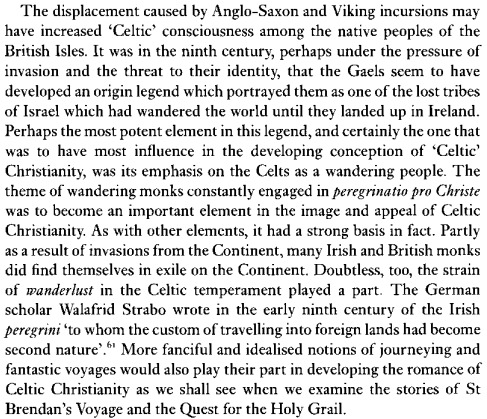
- Ian Bradley, “For all the saints who from their labours rest: The first wave of interest in Celtic Christianity, c. 664-800.” in Celtic Christianity: Making Myths and Chasing Dreams
9 notes
·
View notes
Text
A review of:
The Origins of Ireland's Holy Wells by Celeste Ray
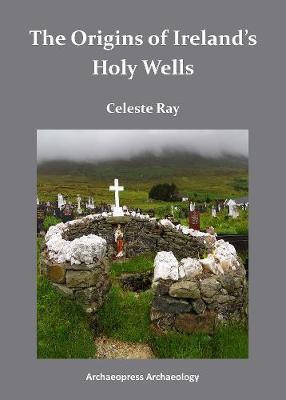
Celeste Ray, a professor of anthropology for the University of the South, USA wrote this book after extensive research, both desk and foot into Irelands Holy Wells. I would honestly recommend anyone with any interest in Irish religious practices, culture, paganism, or mythology to pick it up. An amazing book. I'll be giving my thoughts and what I liked and didn't like about it here.
What I liked:
A very well researched book that shows the authors dedication not just to anthropology but to the living practices she is documenting
The passion of the author is clear and they Mince no words when discussing other researchers and their work, pointing out the flaws, misconceptions and biases (some of which were wild I can't believe some of these people are taken as authorities on the subject when their conclusion was that wells are a toilet metaphor?)
Uses a wider pre roman European context for the evidence. As we are so often reminded, to treat Ireland as some how separate from Western Europe is ridiculous and is a disservice to the interconnection of the people of old.
The reframing of this idea, which is normally used as a strong force against nativist views into a supportive one was quite interesting.
Examines roman writings in a very balanced way that acknowledges the inherent propaganda but does not dismiss it outright.
There's a whole section of people including academics who seems desperate for a roman invasion of ireland, despite there being basically no evidence of it. Like people are fully making things up to try and force one, the author gives these people a sound dismissal in their restating of the evidence of raiding and trade over large-scale roman conquest. (Genuine question can someone explain why people are so mad for Romans in ireland?)
I thus learned more about pre roman Western European practices and archeology than I ever really had the desire to. I am now much more educated on the subject.
The framing of sites as important locations adopted and readopted based on shifting circumstances of the time rather than a "secret unbroken line" which is much more realistic.
The explanation of Holy Wells as archaeologically challenging sites was well explained.
Using etymology in the connection of wells to supernatural beings. Love etymology so this was amazing
The use of early irish literature to support existing claims. Which I know claiming that there are pagan elements in the literature basically gets you spat and jeered at but nevertheless is really compelling.
While this blog has been thoroughly against the lumping together of celtic cultures, this book makes a great case as to when it is appropriate to use the term celtic and that the rush to replace this term has very much resulted in the baby being thrown out with the bath water.
Actually engages with living culture and treats folklore and living sources/practices as evidence to be considered rather than "silly little irish peasants" but also does not take every tale as completely accurate literal history.
Plenty of examples and pictures of well in practice today.
Supports a general pre Christian, pre roman use of wells and springs as sacred sites but also acknowledges the influence of both (especially Christian) on the practice.
Acknowledges the diverse origins of holy wells, from one's that have have votive offerings since the bronze age to ones that were made sacred in the modern age.
Does not buy into any sort of "Christians are thieves" narrative.
Honestly this seems like the definitive book on irish holy wells.
What I didn't like:
While I loved the book there was definitely things I took issue with.
The assertive nature of the tone was entertaining, it did sort of feel like the author was this close to calling other researchers "fucking idiots", though humanities papers seem to have a much more aggressive tone than I am used to from my field of study.
The author makes many an interesting and compelling hypothesis in the book, but they are just that. These theories are then presented as the fact of the matter when really they are no more or less substantiated than the other theories.
Could have done without some of the "identity politics" on the celtic question section. Like I get that's a huge part of this authors work but I didn't feel it was all necessary to include.
Some of the mythological comparisons seem like a little bit of a stretch Low-key.
Either way this is a fantastic work and I urge everyone even remotely interested to buy it, it's a little pricey but well worth it. It can be purchased online on Google books(link). Now obviously this is all from my lay perspective, if anyone with actual qualifications wants to correct or argue feel free. This is just my perspective.
#irish mythology#celtic mythology#irish paganism#gaelic paganism#holy wells#celtic Christianity#ireland#resources#review#mine#anthropology#irish catholic#magic#féile#lúnasa#holy well
50 notes
·
View notes
Text
Healing Blessing
Deep peace I breathe into you,
O weariness, here:
O ache, here!
Deep peace, a soft white dove to you;
Deep peace, a quiet rain to you;
Deep peace, an ebbing wave to you!
Deep peace, red wind of the east from you;
Deep peace, grey wind of the west to you;
Deep peace, dark wind of the north from you;
Deep peace, blue wind of the south to you!
Deep peace, pure red of the flame to you;
Deep peace, pure white of the moon to you;
Deep peace, pure green of the grass to you;
Deep peace, pure brown of the earth to you;
Deep peace, pure grey of the dew to you;
Deep peace, pure blue of the sky to you!
Deep peace of the running wave to you,
Deep peace of the flowing air to you,
Deep peace of the quiet earth to you,
Deep peace of the sleeping stones to you!
Deep peace of the Yellow Shepherd to you,
Deep peace of the Wandering Shepherdess to you,
Deep peace of the Flock of Stars to you,
Deep peace from the Son of Peace to you,
Deep peace from the heart of Mary to you,
From Bridget of the Mantle
Deep peace, deep peace!
-Fiona MacLeod
16 notes
·
View notes
Text
From Kissing Fish Book on facebook:
St. Paddy's Day. A day some people wear green, some get drunk, and others slam Christianity and St. Patrick all together for his alleged "driving the snakes” - read pagans - out of Ireland. I'm calling out that allegation. That fictitious fable is buying into a bogus new age myth. In fact, the Celts received Christianity with ease as it was in sync with their own mythologies. Celtic Christianity was egalitarian, with women priests, and priests able to marry, and much assimilation of Celtic symbols and understandings.
It wasn't until several centuries AFTER Patrick that some bogus most unChristian legends were created by zealous triumphalistic Christians to turn Patrick into some sort of Christian superhero who "kicked pagan butt." That's all shite. Such arrogant chest thumping is worthy of condemning, but that has nothing to do with Patrick (5th Century) and early Celtic Christianity. Celtic Christianity shares MUCH in common with progressive Christianity and was a gift to the world until they were forced to toe the Roman Catholic doctrinal line in the 7th Century; i.e. starting with the Synod of Whitby in 664. ~  RW
"Despite Rome's later philosophic battles against it, like those at the Synod of Whitby in 664 AD, Celtic Christianity remained the dominant form of Christianity in terms of numbers of adherents for the first thousand years of the Christian era. Most modern Christians do not know this because once Rome either converted, suppressed, or killed the adherents of what they saw as a heresy. They removed all reference to Celtic Christianity's legacy from the libraries of Europe - except the Irish libraries, material being translated only since Irish Independence in the early Twentieth Century"
https://simple.wikipedia.org/wiki/Celtic_Christianity
1 note
·
View note
Photo

[Order of Celtic Franciscans, OCF]
34 notes
·
View notes
Text

Houelt Cross
This has been identified with Hywel ap Rhys who was a king of Glywysing (either in part or in its entirety) in South Wales (ruled c. 840–886). The Houelt Cross has a Latin inscription written in half-uncial Latin which has consistently been interpreted as a memorial cross raised by Hywel for his father.
R. A. Stewart Macalister read the inscription as:
"NINOMINEDIPATRISE/TS | PERETUSSANTDIANC | --]UCEMHOUELTPROPE | --]BITPROANIMARESPA | --]ESEUS"
In 1950 Victor Erle Nash-Williams translated it as "In the Name of God the Father and of the Son and of the Holy Spirit. This cross Houelt (PN) prepared for the soul of Res (PN) his father" while in 1976 the Royal Commission on the Ancient and Historical Monuments of Wales translated it as "In the name of God, the Father and the Holy Spirit, Houelt (PN) prepared this cross for the soul of Res (PN) his father".
The Cross itself is a striking example of a Celtic wheel cross and features interlacing carvings, and the work is a lasting reminder of Hywel's wealth and influence.
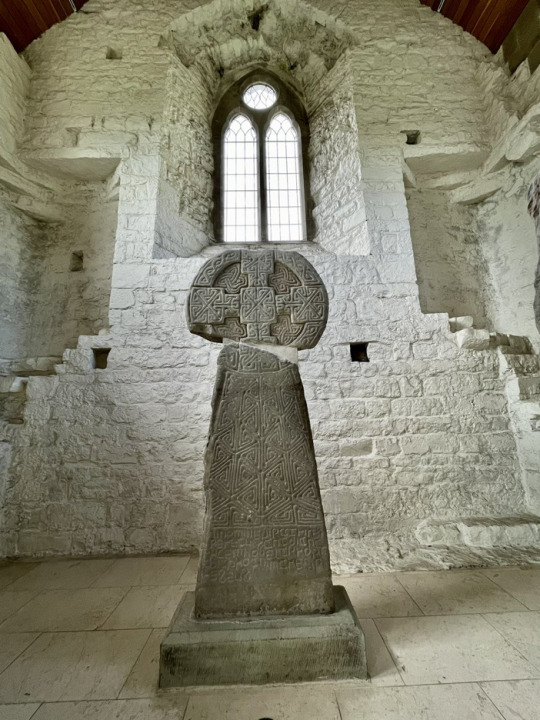
The Houelt Cross can be seen in Llantwit Major - Llanilltud Fawr. The Llanilltud collection of Celtic Christian stones, housed in the Galilee Chapel, includes the Houelt Cross, the Samson or Illtud Cross and the Samson Pillar, all dating from the 9th to 11th century.
3 notes
·
View notes
Text
17th February
St Finan of Lindisfarne’s Day

Lindisfarne. Source: The Heavy Anglophile Orthodox website
Today is St Finan of Lindisfarne’s Day. Unlike many of the British saints, seventh century Finan had no mythological origin story, attributed miracles or pagan antecedent. He was a significant religious and political figure in early British Christianity, fiercely defending the local Celtic church which had survived the Anglo-Saxon incursions, and was on a campaign of its own to convert the Germanic invaders and therefore in conflict with the Church of Rome, also on an evangelical mission amongst the English. From Rome’s perspective, there could be no compromise: it was St Peter’s creation - who was himself the rock upon which Jesus’ vision was to be fulfilled. The Irish and Britons who had maintained Christ’s religion in Britain during the dark days of the barbarian migrations were no more than quaint native survivals, and could not be permitted to dominate the new English church.
Finan however had persuaded the Angle king of Northumbria, Oswiu, to follow the Celtic tradition, which quite suited this wild kingdom of English, Britons and Romano-British nostalgists. Oswiu sent missionaries into the Saxon kingdoms of the south, but met immediate opposition from their pro-Rome Christian counterparts. Ultimately the issues of conflict, which boiled down to the date at which Easter should be celebrated and the type of tonsure the clergy should wear, was resolved at the Synod of Whitby, at which the Roman church’s arguments held sway and Finan was forced to accept the Northumbrian conversion to the Roman Catholic version of the faith. Finan remained a powerful figure in the newly unified church however, and was elevated to sainthood after his death, all previous transgressions apparently forgotten.
1 note
·
View note